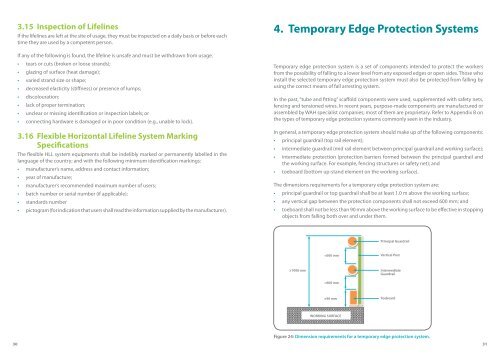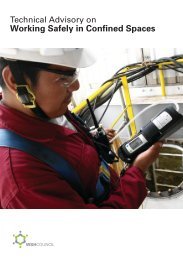HERE - Workplace Safety and Health Council
HERE - Workplace Safety and Health Council
HERE - Workplace Safety and Health Council
Create successful ePaper yourself
Turn your PDF publications into a flip-book with our unique Google optimized e-Paper software.
3.15 Inspection of LifelinesIf the lifelines are left at the site of usage, they must be inspected on a daily basis or before eachtime they are used by a competent person.If any of the following is found, the lifeline is unsafe <strong>and</strong> must be withdrawn from usage.• tears or cuts (broken or loose str<strong>and</strong>s);• glazing of surface (heat damage);• varied str<strong>and</strong> size or shape;• decreased elasticity (stiffness) or presence of lumps;• discolouration;• lack of proper termination;• unclear or missing identification or inspection labels; or• connecting hardware is damaged or in poor condition (e.g., unable to lock).3.16 Flexible Horizontal Lifeline System MarkingSpecificationsThe flexible HLL system equipments shall be indelibly marked or permanently labelled in thelanguage of the country; <strong>and</strong> with the following minimum identification markings:• manufacturer’s name, address <strong>and</strong> contact information;• year of manufacture;• manufacturer’s recommended maximum number of users;• batch number or serial number (if applicable);• st<strong>and</strong>ards number• pictogram (for indication that users shall read the information supplied by the manufacturer).4. Temporary Edge Protection SystemsTemporary edge protection system is a set of components intended to protect the workersfrom the possibility of falling to a lower level from any exposed edges or open sides. Those whoinstall the selected temporary edge protection system must also be protected from falling byusing the correct means of fall arresting system.In the past, “tube <strong>and</strong> fitting” scaffold components were used, supplemented with safety nets,fencing <strong>and</strong> tensioned wires. In recent years, purpose-made components are manufactured orassembled by WAH specialist companies; most of them are proprietary. Refer to Appendix B onthe types of temporary edge protection systems commonly seen in the industry.In general, a temporary edge protection system should make up of the following components:• principal guardrail (top rail element);• intermediate guardrail (mid rail element between principal guardrail <strong>and</strong> working surface);• intermediate protection (protection barriers formed between the principal guardrail <strong>and</strong>the working surface. For example, fencing structures or safety net); <strong>and</strong>• toeboard (bottom up-st<strong>and</strong> element on the working surface).The dimensions requirements for a temporary edge protection system are:• principal guardrail or top guardrail shall be at least 1.0 m above the working surface;• any vertical gap between the protection components shall not exceed 600 mm; <strong>and</strong>• toeboard shall not be less than 90 mm above the working surface to be effective in stoppingobjects from falling both over <strong>and</strong> under them.Principal Guardrail
















